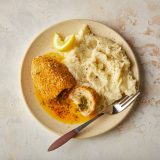War has a way of flipping reality, making mundane the extraordinary and rendering exceptional the everyday. The view of central Kyiv from Ievgen Klopotenko’s living room window, for example. Expressionless Soviet-era high-rises amid clusters of low-slung shops, the gray tedium of Eastern European urbanity.
Except the closest tower—the offices of Ukraine’s electric utility—bore a gaping wound. A Russian missile punched a 15-story hole in it, showering the area with glass and wrenched metal. Some days, the sky around Klopotenko’s own building whirrs and crackles, the soundtrack of Russian drones being met by Ukrainian artillery.
“This is my new reality,” said Klopotenko, Ukraine’s best-known celebrity chef and restaurateur. As he cracked black pepper into ground chicken at his kitchen island, the lights flickered out, the victim of a substation missile strike or maybe just a rolling blackout. It can be hard to know. “There is nothing normal in my life.”
Russia’s invasion has upended the day-to-day in Ukraine, setting chaos as routine. It also triggered an unexpected—and many say overdue—introspection about what it means to be Ukrainian. The answers, of course, are legion. But the one response most everyone offers? Food.

“Food is so much of the identity of a nation,” said Klopotenko, as he patted the chicken into oblongs, rolled them in egg and breadcrumbs twice over, then tossed them in the oven just as the power blinked back on. “Now for us it is important to talk about our identity to the world.”
Even before the war, Klopotenko and a cadre of chefs, historians and others labored to identify, preserve and promote the culinary traditions that set Ukraine apart, an arduous task in an area of the world where culinary overlap is common. The invasion—which Russia justifies in part by arguing Ukraine is not culturally distinct—made the work even more pressing.
Which is what brought me to Klopotenko’s Kyiv apartment. He offered to teach me the foods that define Ukraine. So we feasted on sweet-and-tangy borsch streaked with sour cream; lacy-crisp potato pancakes called deruny; doughy pampushky buns with dill and garlic; a gloriously burnished cheesecake draped with chocolate.
And those chicken oblongs.
When they emerged from the oven, each resembled a meatball married to a corn dog. When I cut into one, a whiff of rich steam escaped as a golden, dill-flecked stream of butter poured out. I dredged a bite through it and tasted. Rich doesn’t capture it. At once tender and crisp, the chicken was buttery, herbal and bright.
It was chicken Kyiv, an oddly iconic dish named for the city where it was created. Kind of. It’s complicated. But this was unlike any chicken Kyiv I’d ever tasted. Mostly because it was delicious. That’s complicated, too.
History of an Icon
Rarely does one dish as perfectly encapsulate a nation’s history, struggles and joys as succinctly as chicken Kyiv. That’s a lot to ask of a food most consider—if these days they consider it at all—a punchline to the frozen foods aisle or a cheap wedding buffet. No matter where you get it, it’s likely to taste 50 years past its prime.
For folks born after the 1980s, an explainer might be in order. For much of the mid-20th century, chicken Kyiv was fine dining de rigueur in the U.S., Europe and Soviet Union. The recipe is deceptively simple. Pound flat a chicken breast, wrap it around a pat of frozen butter, then bread the resulting bundle and deep-fry it.
Theoretically, the exterior crisps, while the meat remains juicy and tender. At the core, a pocket of now-molten butter that gushes onto the plate when the chicken is cut into. And, of course, its popularity triggered spin-offs, notably the ham-and-cheese-filled chicken cordon bleu.
Trouble is, chicken breasts are unforgiving, easily turning rubbery and dry. And breading hates adhering to them, sloughing off at the first touch of fork and knife. They also are difficult to season, though honestly, few seasonings beyond a spare sprig of dill seem ever to be harmed in the making of most chicken Kyiv recipes.
The result is the Platonic form of tasteless, tough chicken. So how did we get here?
The history of chicken Kyiv is a muddle. It earned its name when Ukrainian chefs—likely during the early 1900s at the Continental Hotel in Kyiv—seeking a dish worthy of visiting dignitaries, wrapped a chicken breast around butter before breading and frying it. It was a hit and spread quickly across the Soviet Union.
Though few Ukrainians knew chicken Kyiv by name, by World War II it had migrated to menus across the U.S. and Europe. Mikhail Gorbachev even served it at the Soviet Embassy in Washington. Officially a fad, it soon made the short jump to the frozen foods aisle so anyone could feel fancy.
A Fast Food Clue
Though a visit to Kyiv—the preferred Ukrainian spelling, rather than the Russian-inflected Kiev—these days is challenging, the city’s restaurants most nights are packed despite curfews and frequent air raids. That’s thanks in part to the efforts of Klopotenko and others urging people to eat Ukrainian.
With the war, food became a rallying cry, one that intensified after UNESCO in 2022 gave Ukraine bragging rights to borsch (again, the preferred Ukrainian spelling), calling it an asset of “intangible cultural heritage.” Russia wasn’t pleased. “The war accelerated the growing up of Ukrainian culture,” Klopotenko said. “Russia wanted to kill Ukrainian culture, but it did the opposite.”
This culinary refocusing has Ukrainians questioning the origins of the foods they eat and reaching for recipes closer to home. That made for a fascinating—if sometimes heartbreaking—time to eat my way through the city, where every cook—home and professional—was eager to share family recipes for tender dumplings (called varenyky) and bright, meaty borsch.
Everything was delicious. Except the chicken Kyiv. I’d hoped eating it in its hometown would be transformative. But the hotel rumored to have created it is long shuttered, few people make it at home, and every restaurant plated up the same overcooked, underseasoned chicken breast in a pool of butter and a pile of breading that refused to stick
That is, until I reluctantly visited a literal hole in the wall—a window next to an adult bookstore along the back side of Khreshchatyk Street, the city’s central artery otherwise lined with neoclassical Stalinist buildings. The sign at the window summed it up: “We Feed You the Legendary Chicken Kyiv.”
A flow of teenagers and families approached the window to order, the chicken Kyiv emerging rapid fire, wrapped in paper pouches to be eaten out of hand. Fine dining, indeed. Not quite the transformative experience I’d hoped for.
Until it was. I ordered, took a bite and soon had melted butter splurting down my hand. Clearly, there is an art to eating chicken Kyiv as a hand pie. But delivery method aside, it was fantastic. The meat was tender, juicy and seasoned. The butter, too, was seasoned. Tons of dill and pepper. And the crisp breading didn’t budge!
I ordered a second, which I dissected while standing in the snow. The difference was clear. The meat was ground chicken, not the same bland whole breasts used everywhere else. Ground meat is slower to turn tough and dry. It also is easier to season, and creates the perfect craggy surface for breading to adhere to. It was delicious. But was it really chicken Kyiv?
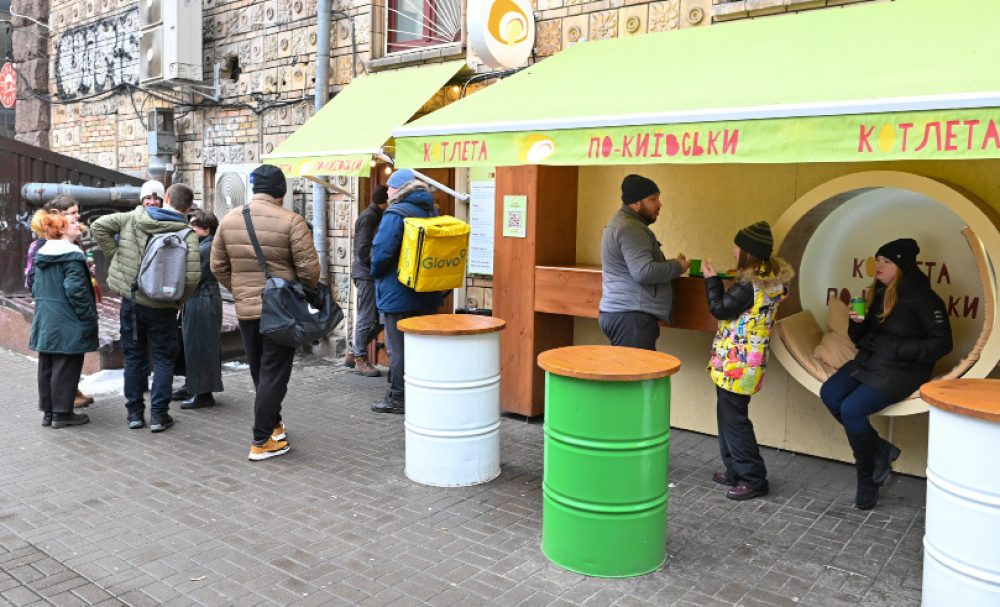
History Redux
What if chicken Kyiv’s story didn’t begin in Kyiv during the early 1900s? That may be where and when it got its name and fame, but its origins actually date far earlier, Klopotenko told me. As I said, complicated.
Ukrainians—in fact, many Eastern Europeans—have had some sort of fried minced meat patty in their culinary repertoire pretty much as long as there have been scraps of meat to salvage. How those patties came to be stuffed with butter is debated. But as with most matters such as this, we probably can blame the French.
The 1800s was an era when France defined aspirational cooking; chefs from around the world studied there, using what they learned to elevate their own countries’ cuisines. So goes the theory that around 1840, Russian royalty sent chefs to butter-loving France, where they learned an upgrade to those minced chicken patties.
Those chefs influenced others who influenced others across the region, and soon butter-stuffed minced chicken patties had spread. Seasonings were added—dill, of course, but also ginger, smoked paprika, saffron and lemon. All once were common in Ukrainian cooking, Klopotenko explained. The result was something similar to the chicken Kyiv I ate on the street.
Then the Soviet Union. When Ukraine was subsumed by the USSR in 1922, its culture was quashed in favor of uniformity. Ukrainian cuisine lost much of what made it distinct. Chicken Kyiv was one of many victims.
Which is why when some hotel chef in early 1900s Kyiv wanted a fancier version of those buttery minced meat patties, he turned not to spices or herbs, but to a whole chicken breast, a pricier cut. Presentation over flavor, I suppose.
The Pre-Soviet Solution
The secret to a better chicken Kyiv turned out to be returning it to its pre-Soviet roots. Ukraine gained independence in 1991, but its cuisine didn’t bounce back. Hence, the sad state of most of the chicken Kyiv I ate. But Klopotenko offered to teach me a pre-Soviet, home cook-friendly version.
Though most Ukrainians would call it simply kuryacha kotleta, or chicken cutlet, plenty of them do make chicken Kyiv at home. But not the modern whole-breast version. All that nipping, tucking, wrapping and frying while trying to seal in the butter, only to have it be tasteless and overcooked anyway? An unrewarding art. Ground chicken is another matter.
Klopotenko’s method was simple. It also took advantage of the ease with which ground meat can be thoroughly seasoned. In both the chicken and butter, he used a generous hand adding salt and pepper, ginger and garlic, smoked paprika, too. The resulting compound butter was formed into balls, then frozen for ease of stuffing at the center of the ground meat.
The chicken oblongs also took a turn in the freezer, which made them easier to handle during the traditional coating of flour, then egg, then breadcrumbs, then back again for a second coating of each. Tradition calls for frying, but Klopotenko favors the more modern—easier and less greasy—approach of baking them.
The result was spectacular. The breading was crisp and satisfying, not sodden with oil. And it stayed in place, ensuring a satisfying crunch to contrast each bite of tender, flavorful meat. The butter, flecked with seasonings, slid onto the plate, creating a delicious sauce. I’m still not convinced it’s street food to eat out of hand, but it was wonderful all the same.
A fitting transformation for a dish elevated from humble origins, only to be so much better for returning to them.
Chicken Kyiv
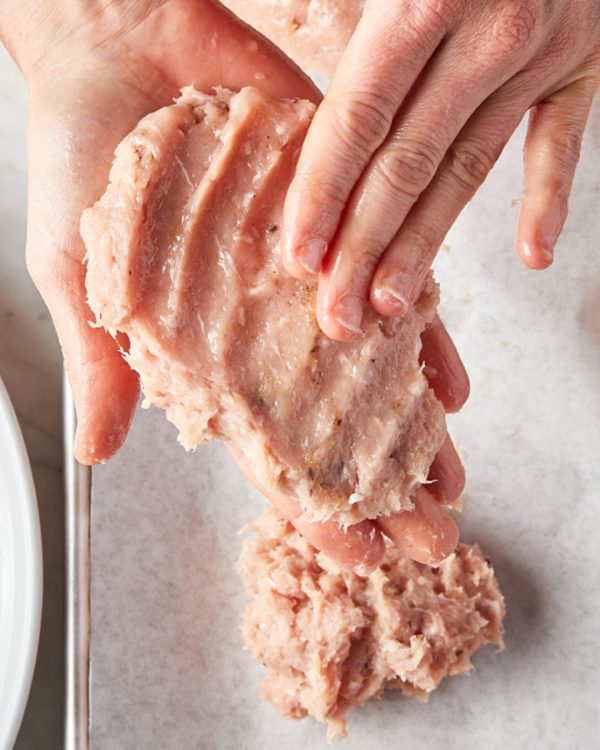
1. Using lightly oiled hands, press and shape one portion of the seasoned ground chicken into a roughly flat oval about 4 inches long.
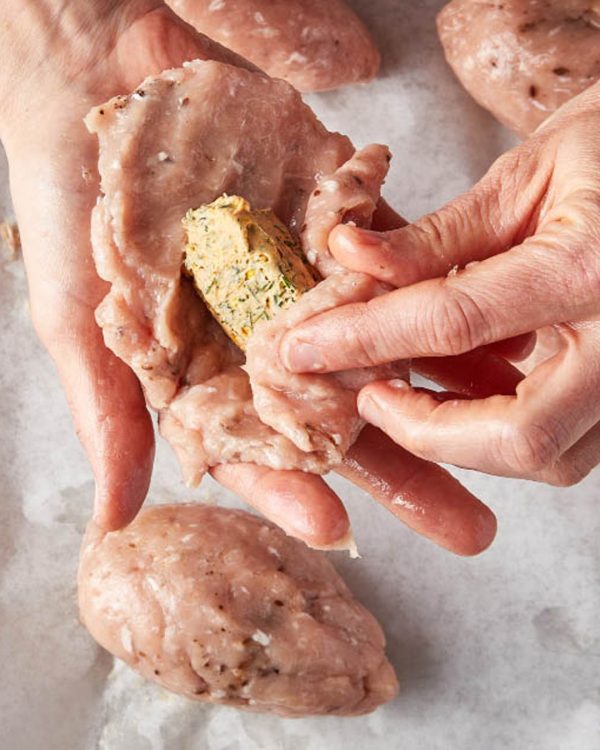
2. Place 1 butter portion in the center, then enclose it in the meat. Form the butter-filled chicken into a 4-inch football shape.
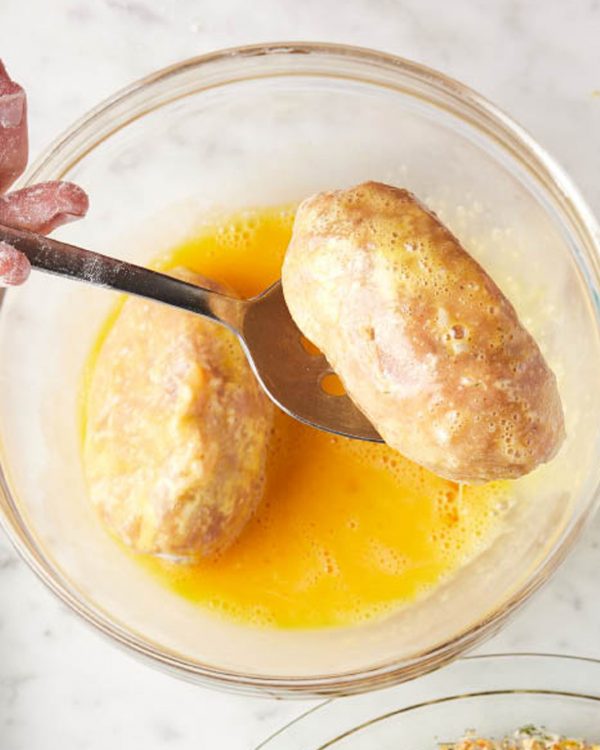
3. One at a time, roll each in flour, turning to coat, then shake off the excess flour before coating all sides with egg.
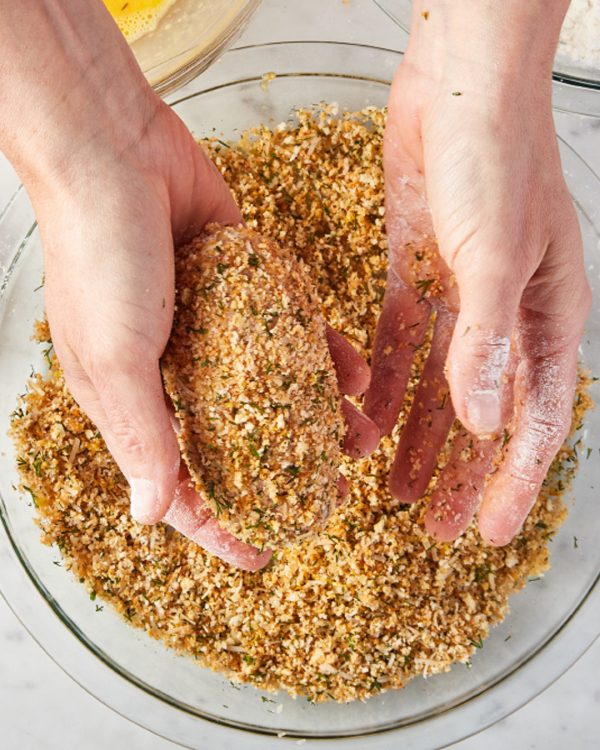
4. Coat on all sides with the panko mixture, pressing lightly so it adheres, then return to the baking sheet for freezing.
